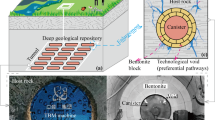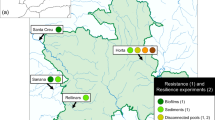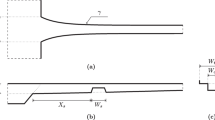Abstract
Intertidal flats regularly emerge and submerge in accordance with changes to the water level occurring over tidal cycles. The alteration between wet and drained states may affect the sediment water content, and so the erosion properties of intertidal sediments. This study examined the influence of ambient temperature on the erodibility of exposed cohesive sediment from an intertidal mudflat in the Firth of Thames, New Zealand, in December 2017 and March 2018. The EROMES device was used to measure the erosion potential of sediment (erosion threshold, τcr N m−2, and erosion rate, ER g m−2 s−1). Samples were drained and exposed to temperatures of 0, 8, 25 and 40 °C, chosen to mimic natural exposed conditions, while submerged samples simulated natural flooded conditions. Results showed that the cohesive sediment became more resistant to erosion when exposed to air compared with submerged samples as a consequence of decreased water content. The water content of exposed sediments decreased by 1.01–1.78 times, a rate which was a function of increasing temperature. The τcr of exposed experiments was 1.2 to 2.2 times higher, whereas ER decreased 1.2 to 6.2 times. Both the December 2017 and March 2018 sampling dates showed a similar pattern of increasing resistance to erosion (higher τcr and lower ER), which corresponded to depleted water content of the exposed sediment at higher temperatures.





Similar content being viewed by others
Change history
15 November 2019
In section Erosion measurements, the reference Friend et al. 2003 should be removed from the first five lines.
References
Amaryan L (1993) Soft soil properties and testing methods. AA Balkema, Rotterdam
Amos CL, Van Wagoner NA, Daborn GR (1988) The influence of subaerial exposure on the bulk properties of fine-grained intertidal sediment from Minas Basin, Bay of Fundy. Estuar Coast Shelf Sci 27(1):1–13. https://doi.org/10.1016/0272-7714(88)90028-5
Amos CL, Droppo IG, Gomez EA, Murphy TP (2003) The stability of a remediated bed in Hamilton Harbour, Lake Ontario, Canada. Sedimentology 50(1):149–168
Andersen T (2001) Seasonal variation in erodibility of two temperate, microtidal mudflats. Estuar Coast Shelf Sci 53(1):1–12. https://doi.org/10.1006/ecss.2001.0790
Andersen TJ, Pejrup M (2002) Biological mediation of the settling velocity of bed material eroded from an intertidal mudflat, the Danish Wadden Sea. Estuar Coast Shelf Sci 54(4):737–745. https://doi.org/10.1006/ecss.2001.0856
Andersen TJ, Lund-Hansen LC, Pejrup M, Jensen KT, Mouritsen KN (2005) Biologically induced differences in erodibility and aggregation of subtidal and intertidal sediments: a possible cause for seasonal changes in sediment deposition. J Mar Syst 55(3–4):123–138. https://doi.org/10.1016/j.jmarsys.2004.09.004
Andersen TJ, Fredsoe J, Pejrup M (2007) In situ estimation of erosion and deposition thresholds by Acoustic Doppler Velocimeter (ADV). Estuar Coast Shelf Sci 75(3):327–336. https://doi.org/10.1016/j.ecss.2007.04.039
Andersen TJ, Lanuru M, van Bernem C, Pejrup M, Riethmueller R (2010) Erodibility of a mixed mudflat dominated by microphytobenthos and Cerastoderma edule, East Frisian Wadden Sea, Germany. Estuar Coast Shelf Sci 87(2):197–206. https://doi.org/10.1016/j.ecss.2009.10.014
Arar EJ, Collins GB (1997) Method 445.0: in vitro determination of chlorophyll a and pheophytin a in marine and freshwater algae by fluorescence. United States Environmental Protection Agency, Office of Research and Development, National Exposure Research Laboratory, Cincinnati
Austen I, Andersen TJ, Edelvang K (1999) The influence of benthic diatoms and invertebrates on the erodibility of an intertidal mudflat, the Danish Wadden Sea. Estuar Coast Shelf Sci 49(1):99–111. https://doi.org/10.1006/ecss.1998.0491
Bartzke G, Bryan KR, Pilditch CA, Huhn K (2013) On the stabilising influence of silt on sand beds. J Sediment Res 83(8):691–703
Bartzke G, Huhn K, Bryan KR (2017) A computational investigation of the interstitial flow induced by a variably thick blanket of very fine sand covering a coarse sand bed. Geo-Mar Lett 37(5):457–474. https://doi.org/10.1007/s00367-017-0502-x
Borsje BW, de Vries MB, Hulscher SJ, de Boer GJ (2008) Modeling large-scale cohesive sediment transport affected by small-scale biological activity. Estuar Coast Shelf Sci 78(3):468–480. https://doi.org/10.1016/j.ecss.2008.01.009
Cambell G, Mulla D (1990) Measurement of soil water content and potential. Agronomy (30):127–142
Chappell PR (2014) The climate and weather of Waikato: NIWA. https://www.niwa.co.nz/static/Waikato%20ClimateWEB.pdf. Accessed 11/4/2017
Collins M, Knutti R (2013) Long-term Climate Change: Projections, Commitments and Irreversibility. In: Climate Change 2013: The Physical Science Basis. Contribution of Working Group I to the Fifth Assessment Report of the Intergovernmental Panel on Climate Change. Cambridge University Press, Cambridge and New York.http://www.climatechange2013.org/images/report/WG1AR5_Chapter12_FINAL.pdf. Accessed 19/7/2018
Czurda K, Ludwig S, Schababerle R, Hartge K, Stewart B (1995) Fabric changes in plastic clays by freezing and thawing. Soil structure: Its development and function. Advance in Soil Science. Lewis Pub., New York, 71-91.
Dagesse DF (2013) Freezing cycle effects on water stability of soil aggregates. Can J Soil Sci 93(4):473–483
Daly C, Bryan KR (2011) Morphodynamics of embayed beaches: the effect of wave conditions. J Coast Res SI 64(64):1003–1007
Davarzani H, Smits K, Tolene RM, Illangasekare T (2014) Study of the effect of wind speed on evaporation from soil through integrated modeling of the atmospheric boundary layer and shallow subsurface. Water Resour Res 50(1):661–680. https://doi.org/10.1002/2013WR013952
Day P (1965) Particle fractionation and particle-size analysis. In: Black CA (ed) Methods of soil analysis. American Society of Agronomy, Madison
Dingman SL (1994) Physical hydrology. Macmillan Publishing Company, London.
Fagherazzi S, Viggato T, Vieillard A, Mariotti G, Fulweiler R (2017) The effect of evaporation on the erodibility of mudflats in a mesotidal estuary. Estuar Coast Shelf Sci 194:118–127. https://doi.org/10.1016/j.ecss.2017.06.011
Fiot J, Gratiot N (2006) Structural effects of tidal exposures on mudflats along the French Guiana coast. Mar Geol 228(1–4):25–37. https://doi.org/10.1016/j.margeo.2005.12.009
Franz G, Pinto L (2014) Modelling of cohesive sediment dynamics in tidal estuarine systems: case study of Tagus estuary, Portugal. Estuar Coast Shelf Sci 151:34–44. https://doi.org/10.1016/j.ecss.2014.09.017
Friend P, Ciavola P, Cappucci S, Santos R (2003) Bio-dependent bed parameters as a proxy tool for sediment stability in mixed habitat intertidal areas. Cont Shelf Res 23(17–19):1899–1917. https://doi.org/10.1016/j.csr.2002.12.001
Fujino K, Lewis E, Perkin R (1974) The freezing point of seawater at pressures up to 100 bars. J Geophys Res 79(12):1792–1797
Gillott JE (2012) Clay in engineering geology, vol 41. Elsevier, Amsterdam
Grabowski RC, Droppo IG, Wharton G (2011) Erodibility of cohesive sediment: the importance of sediment properties. Earth Sci Rev 105(3–4):101–120. https://doi.org/10.1016/j.earscirev.2011.01.008
Han J, Zhou Z (2013) Dynamics of soil water evaporation during soil drying: laboratory experiment and numerical analysis. Sci World J 2013:1–10
Harris RJ, Pilditch CA, Greenfield BL, Moon V, Kröncke I (2016) The influence of benthic macrofauna on the erodibility of intertidal sediments with varying mud content in three New Zealand estuaries. Estuar Coasts 39(3):815–828. https://doi.org/10.1007/s12237-015-0036-2
Hewitt J, Cummings V (2003) The role of waves in the colonisation of terrestrial sediments deposited in the marine environment. J Exp Mar Biol Ecol 290(1):19–47. https://doi.org/10.1016/S0022-0981(03)00051-0
Houwing EJ (1999) Determination of the critical erosion threshold of cohesive sediments on intertidal mudflats along the Dutch Wadden Sea coast. Estuar Coast Shelf Sci 49(4):545–555
Hunt S, Bryan KR, Mullarney JC (2015) The influence of wind and waves on the existence of stable intertidal morphology in meso-tidal estuaries. Geomorphology 228:158–174. https://doi.org/10.1016/j.geomorph.2014.09.001
Jacobs W, Le Hir P, Van Kesteren W, Cann P (2011) Erosion threshold of sand-mud mixtures. Cont Shelf Res 31(10):S14–S25. https://doi.org/10.1016/j.csr.2010.05.012
Kirwan ML, Temmerman S, Skeehan EE, Guntenspergen GR, Fagherazzi S (2016) Overestimation of marsh vulnerability to sea level rise. Nat Clim Chang 6(3):253. https://doi.org/10.1038/nclimate2909
Kobayashi T, Miyagawa K (1992) A method for estimating the daily amount of evaporation from bare soils with dry surfaces. Journal of Japan Society of Hydrology and Water Resources. 4. 37-43. https://doi.org/10.3178/jjshwr.4.3_37.
Lehrsch G, Sojka R, Jolley P (1993) Freezing effects on aggregate stability of soils amended with lime and gypsum. Catena-Verlag, Cremlingen-Destedt, 115-127.
Matthiessen MK, Larney FJ, Brent Selinger L, Olson AF (2005) Influence of loss-on-ignition temperature and heating time on ash content of compost and manure. Commun Soil Sci Plant Anal 36(17–18):2561–2573. https://doi.org/10.1080/00103620500257242
McCarthy JJ (2001) Climate change 2001: impacts, adaptation, and vulnerability: contribution of Working Group II to the third assessment report of the Intergovernmental Panel on Climate Change: Cambridge University Press, Cambridge.
Migné A, Spilmont N, Davoult D (2004) In situ measurements of benthic primary production during emersion: seasonal variations and annual production in the Bay of Somme (eastern English Channel, France). Cont Shelf Res 24(13–14):1437–1449. https://doi.org/10.1016/j.csr.2004.06.002
Montgomery J, Bryan K, Horstman E, Mullarney J (2018) Attenuation of tides and surges by mangroves: contrasting case studies from New Zealand. Water 10:1119. https://doi.org/10.3390/w10091119
Murphy R, Tolhurst T, Chapman M, Underwood A (2009) Seasonal distribution of chlorophyll on mudflats in New South Wales, Australia measured by field spectrometry and PAM fluorometry. Estuar Coast Shelf Sci 84(1):108–118. https://doi.org/10.1016/j.ecss.2009.06.003
Nemes A, Rawls WJ, Pachepsky YA (2005) Influence of organic matter on the estimation of saturated hydraulic conductivity. Soil Sci Soc Am J 69(4):1330–1337
Paterson DM (1989) Short-term changes in the erodibility of intertidal cohesive sediments related to the migratory behavior of epipelic diatoms. Limnol Oceanogr 34(1):223–234. https://doi.org/10.4319/lo.1989.34.1.0223
Paterson DM, Black KS (2000) Temporal variability in the critical erosion threshold of saltmarsh and upper intertidal sediments. British Saltmarshes. Forrest Text for the Linnean Society of London, Ceredigion, pp 51–63
Schünemann M, Kühl H (1991) A device for erosion-measurements on naturally formed muddy sediments: the EROMES-System. Report of GKSS Research Centre GKSS 91/E/18. p 28.
Snelgrove PV (1999) Getting to the bottom of marine biodiversity: sedimentary habitats: ocean bottoms are the most widespread habitat on earth and support high biodiversity and key ecosystem services. Bioscience 49(2):129–138. https://doi.org/10.2307/1313538
Sterling EJ, Hurley MM (2008) Vietnam: a natural history. Yale University Press, New Haven and London.
Sutherland T, Amos C, Grant J (1998) The effect of buoyant biofilms on the erodibility of sublittoral sediments of a temperate microtidal estuary. Limnol Oceanogr 43(2):225–235. https://doi.org/10.4319/lo.1998.43.2.0225
Swales A, Bentley SJ Sr, Lovelock CE (2015) Mangrove-forest evolution in a sediment-rich estuarine system: opportunists or agents of geomorphic change? Earth Surf Process Landf 40:1672–1687. https://doi.org/10.1002/esp.3759
Swales A, Reeve G, Cahoon D, Lovelock C (2019) Landscape evolution of a fluvial sediment-rich Avicennia marina mangrove forest: insights from seasonal and inter-annual surface-elevation dynamics. Ecosystems:1–24. https://doi.org/10.1007/s10021-018-0330-5
Thrush SF, Hewitt JE (2003) Habitat change in estuaries: predicting broad-scale responses of intertidal macrofauna to sediment mud content. Mar Ecol Prog Ser 263:101–112
Urumović K, Urumović SK (2016) The referential grain size and effective porosity in the Kozeny–Carman model. Hydrol Earth Syst Sci 20(5):1669–1680. https://doi.org/10.5194/hess-20-1669-2016
Van Ledden M, Van Kesteren W, Winterwerp J (2004) A conceptual framework for the erosion behaviour of sand-mud mixtures. Cont Shelf Res 24(1):1–11. https://doi.org/10.1016/j.csr.2003.09.002
Volk E, Iden SC, Furman A, Durner W, Rosenzweig R (2016) Biofilm effect on soil hydraulic properties: experimental investigation using soil-grown real biofilm. Water Resour Res 52:5813–5828. https://doi.org/10.1002/2016WR018866
Widdows J, Brinsley M, Bowley N, Barrett C (1998) A benthic annular flume for in situ measurement of suspension feeding/biodeposition rates and erosion potential of intertidal cohesive sediments. Estuar Coast Shelf Sci 46(1):27–38. https://doi.org/10.1006/ecss.1997.0259
Winterwerp JC, Van Kesteren WG (2004) Introduction to the physics of cohesive sediment dynamics in the marine environment (Vol. 56). Elsevier, San Diego, CA. eBook ISBN: 9780080473734.
Winterwerp JC, Zhou Z (2018) Efficient consolidation model for morphodynamic simulations in low-SPM environments. J Hydraul Eng 144(8):04018055. https://doi.org/10.1061/(ASCE)HY.1943-7900.0001477
Xu D, Bai Y, Ji C, Williams J (2015) Experimental study of the density influence on the incipient motion and erosion modes of muds in unidirectional flows: the case of Huangmaohai Estuary. Ocean Dyn 65(2):187–201
Yong RN, Warkentin BP (1966) Introduction to soil behavior. The Macmillan Company, New York
Zhang M, Yu G (2017) Critical conditions of incipient motion of cohesive sediments. Water Resour Res 53:7798–7815. https://doi.org/10.1002/2017WR021066
Zhou Z, Coco G, van der Wegen M, Gong Z, Zhang C, Townend I (2015) Modeling sorting dynamics of cohesive and non-cohesive sediments on intertidal flats under the effect of tides and wind waves. Cont Shelf Res 104:76–91
Zhou Z, van der Wegen M, Jagers B, Coco G (2016a) Modelling the role of self-weight consolidation on the morphodynamics of accretional mudflats. Environ Model Softw 76:167–181. https://doi.org/10.1016/j.envsoft.2015.11.002
Zhou Z, Ye Q, Coco G (2016b) A one-dimensional biomorphodynamic model of tidal flats: sediment sorting, marsh distribution, and carbon accumulation under sea level rise. Adv Water Resour 93:288–302. https://doi.org/10.1016/j.advwatres.2015.10.011
Zhou Z, Coco G, Townend I, Olabarrieta M, Van Der Wegen M, Gong Z, … Gelfenbaum G (2017) Is “morphodynamic equilibrium” an oxymoron? Earth Sci Rev, 165, 257–267. https://doi.org/10.1016/j.earscirev.2016.12.002
Acknowledgments
We would like to thank Benjamin Stewart, John Montgomery, Hieu Dao and Pradeep Sign for their invaluable assistance in the field. We also highly appreciate prompt and enthusiastic support from Dean Sandwell, Erik Horstman and Rebecca Gallagher in assisting with laboratory work. The authors especially thank Assoc. Prof. Zeng Zhou at Hohai University for helpful comments. We are thankful to the two anonymous reviewers for the time taken to make a constructive critique of our work.
Funding
This research has been funded by the University of Waikato Doctoral Scholarship for international students awarded to Hieu M. Nguyen. The Tipping Points project in the Dynamic Seas programme of the New Zealand Sustainable Seas National Science Challenge (CO1x1515 4.2.1) supported Karin Bryan and Conrad Pilditch.
Author information
Authors and Affiliations
Corresponding author
Additional information
Publisher’s note
Springer Nature remains neutral with regard to jurisdictional claims in published maps and institutional affiliations.
Rights and permissions
About this article
Cite this article
Nguyen, H.M., Bryan, K.R., Pilditch, C.A. et al. Influence of ambient temperature on erosion properties of exposed cohesive sediment from an intertidal mudflat. Geo-Mar Lett 39, 337–347 (2019). https://doi.org/10.1007/s00367-019-00579-x
Received:
Accepted:
Published:
Issue Date:
DOI: https://doi.org/10.1007/s00367-019-00579-x




